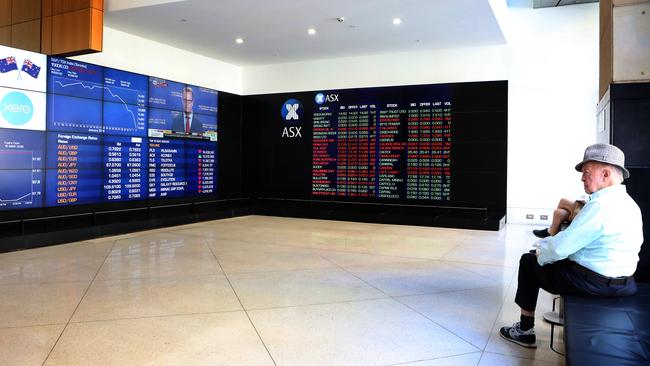Profit reports look good however a low number of companies surprised to the upside
Australia’s biggest companies have overall met expectations for earnings and dividends, while showing sensitivity to a deteriorating economic outlook.

Australia’s biggest companies largely met expectations for earnings and dividends but the December half-year reporting season has shown sensitivity to a deteriorating economic outlook and costs are tipped to keep rising.
Based on AMP’s numbers, 57 per cent of reporting companies increased profits and 54 per cent increased dividends compared with a year ago – below long-term averages of 64 per cent and 58 per cent respectively but slightly better than for the June half year.
A lower-than-normal 29 per cent of profits surprised positively while just over a third surprised on the downside, which was higher than usual.
“While companies appear to have so far weathered cost pressures and rate hikes reasonably well, corporate comments suggest that the post-Christmas trading environment for consumer facing companies appears to be getting tougher with increasing resistance to buying big-ticket items and some shifting to discount stores,” AMP Capital senior economist Diana Mousina said.

Investors were pleasantly surprised by the resilience of bank earnings in October along with the resilience of sales updates from retailers in January.
Still, results from banks in recent weeks showed their earnings have peaked, with credit growth slowing, net interest margins likely to deteriorate and bad debts likely to rise.
As a result, consensus earnings expectations for the current financial year have been revised down to 7.2 per cent from 7.7 per cent at the start of the earnings season, according to AMP.
A 2.2 per cent fall in the ASX 200 share index during reporting season made it the worst in terms of share price performance since August 2019 – except for February 2020 when Covid-19 hit.
But it was more a function of January’s sharp rise and hawkish central bank rhetoric in February.
While corporate Australia is counting on a “soft landing” as inflation slows during the most aggressive interest rate increases in decades and as China ends restrictions, strategists are cautious as companies face an economic slowdown amid still-elevated costs.

“The results in terms of profits look pretty impressive, but they reflect the economy that we’ve been in, as opposed to the one we are going into,” said UBS Australia equity strategist Richard Schellbach.
“Last year we had tailwinds coming from the reopening after the pandemic, and the fact that earnings were at such a depressed level compared to the year before that.”
That created a great backdrop in terms of profit results that beat expectations, showing strong earnings growth and an overall mix of factors that were well aligned.
Most corporates are still feeling some tailwinds from household spending which is supported by low unemployment and elevated savings, the full effects of interest rate hikes are yet to be felt and there’s still a large backlog of construction work that’s yet to be completed.
“Once you go beyond that and you isolate the trading updates of companies and, in particular, their outlooks – across pretty much all sectors – there’s certainly been a turn for the worse,” Mr Schellbach said.
“Hence, fears of an economic slowdown and a ‘hard landing’ for the housing market have stepped up, and that’s ultimately what we have seen in terms of earnings revisions.
“Whether companies beat or missed their profit expectations, there was a loss of momentum.”
On his numbers, there were equal numbers of companies that beat and missed profit expectations, “which is actually a pretty weak number” as normally about two-thirds beat expectations.

But the change in consensus estimates for future earnings has been “unequivocally negative.”
“Both companies and the analyst community are coming to the realisation that the economy will slow, the outlook for interest rates is higher, the position of consumers will worsen, and the situation in the property market is for another tough few quarters,” he said.
Barrenjoey chief macro strategist Damien Boey said the banks were losing their recent positive leverage to rising interest rates as net interest margins looked to be peaking.
“There is evidence from bank results that on a monthly basis, net interest margins may have peaked, with investors now thinking about the deleterious effects of competition and political developments on margins, let alone the sensitivity of credit growth and bad debts to higher rates,” Mr Boey said.
“Our banks analysts believe that rate hikes from here are a headwind and not a tailwind.”

In his view, insurance companies will now give better positive leverage to rising interest rates.
Still, MST senior analyst Hasan Tevfik said a high cost base for companies continued to be a concern.
“The story for the past six months is that revenues have been stronger than what anyone thought, but costs are beating revenues,” said Mr Tevfik.
“The concern is that at the very start of an economic downturn, which would feed through into weaker revenues, if you go into a downturn with an elevated cost base, that’s more dangerous.”
But while a margin squeeze is a risk, he said operating leverage was generally rising from low levels.
Mr Tevfik said some costs – like raw materials costs and freight – had been surprisingly persistent.
“Some companies, like ResMed, are talking about an easing of supply chains and lower freight rates, but other companies, like Coles, indicate that domestic logistics is quite messy,” he said.
“There is a cost there where I thought there would be clearer signs of cost deflation.
“Then the biggest one, which is quite worrying because it’s hard to offset, is labour costs.”




To join the conversation, please log in. Don't have an account? Register
Join the conversation, you are commenting as Logout